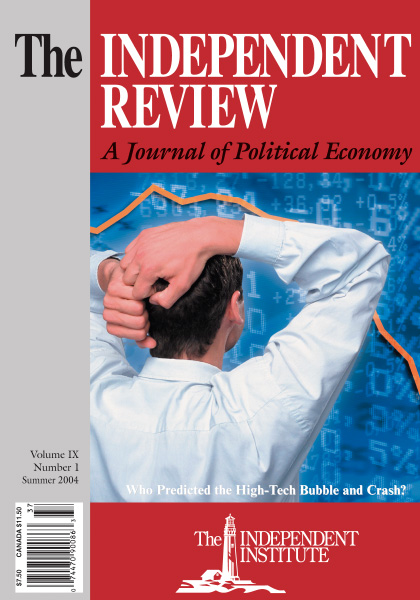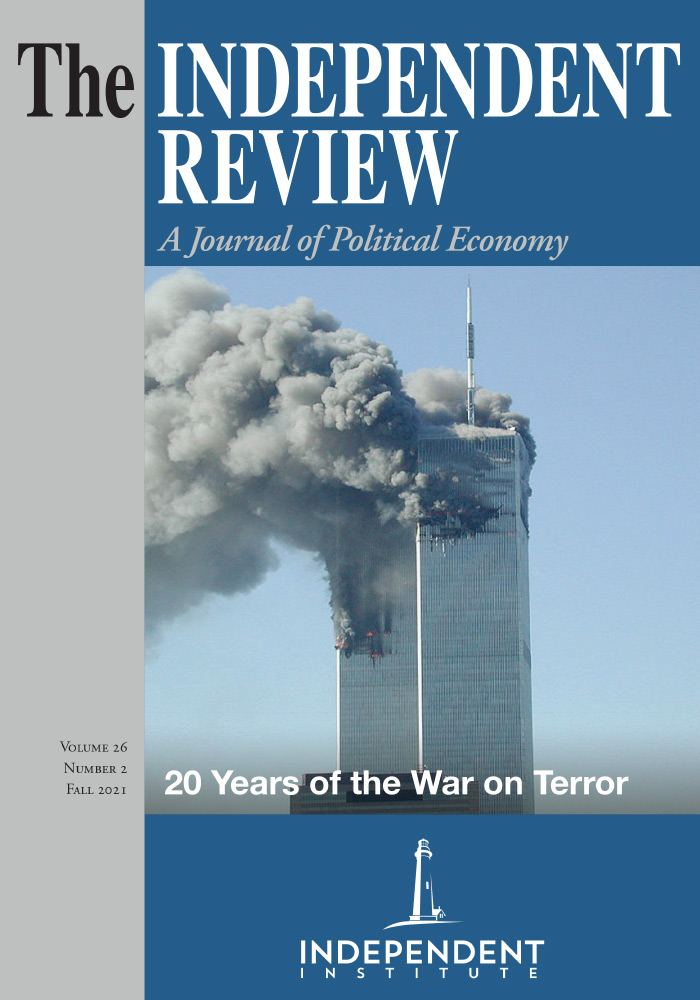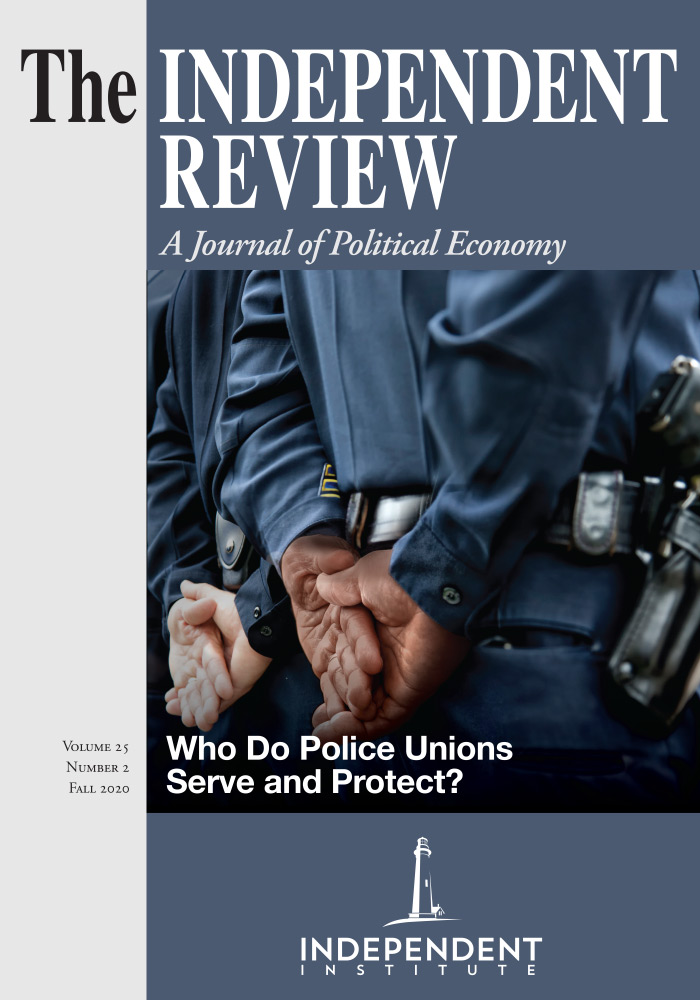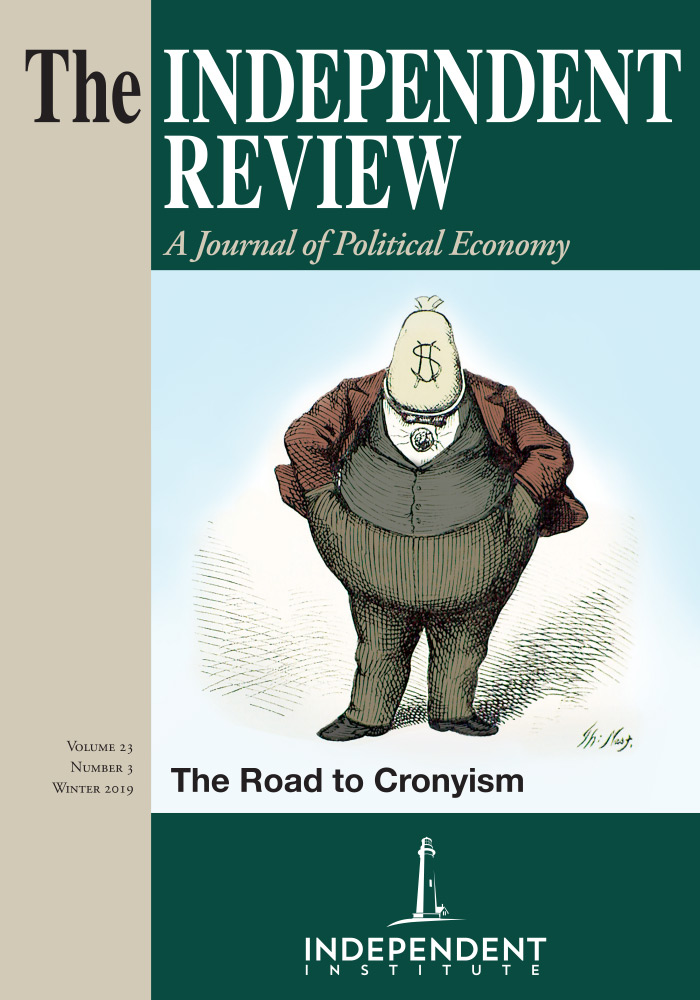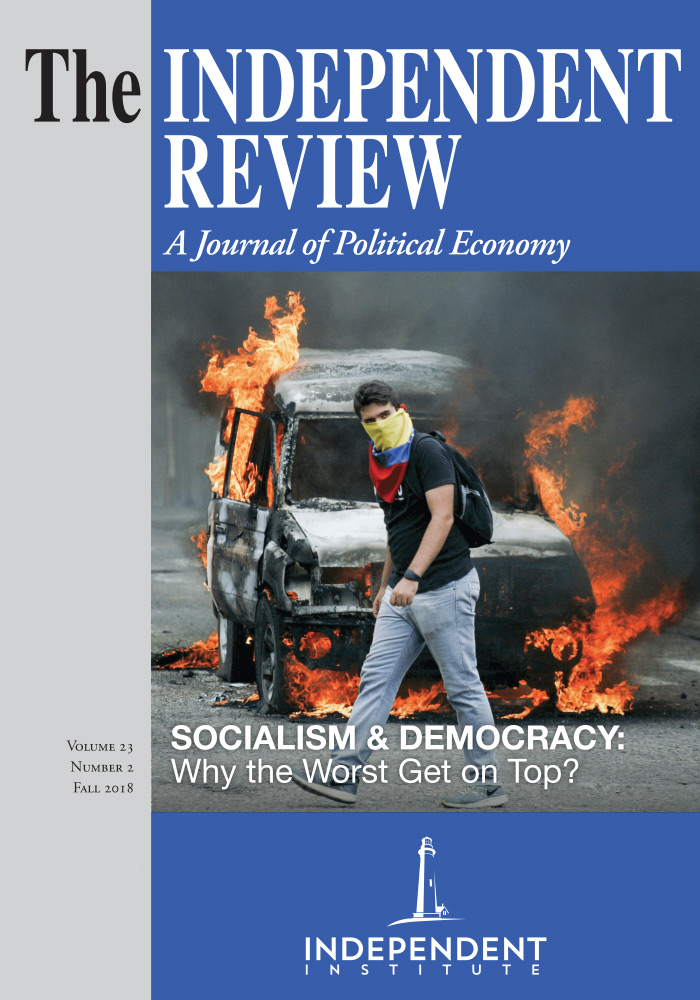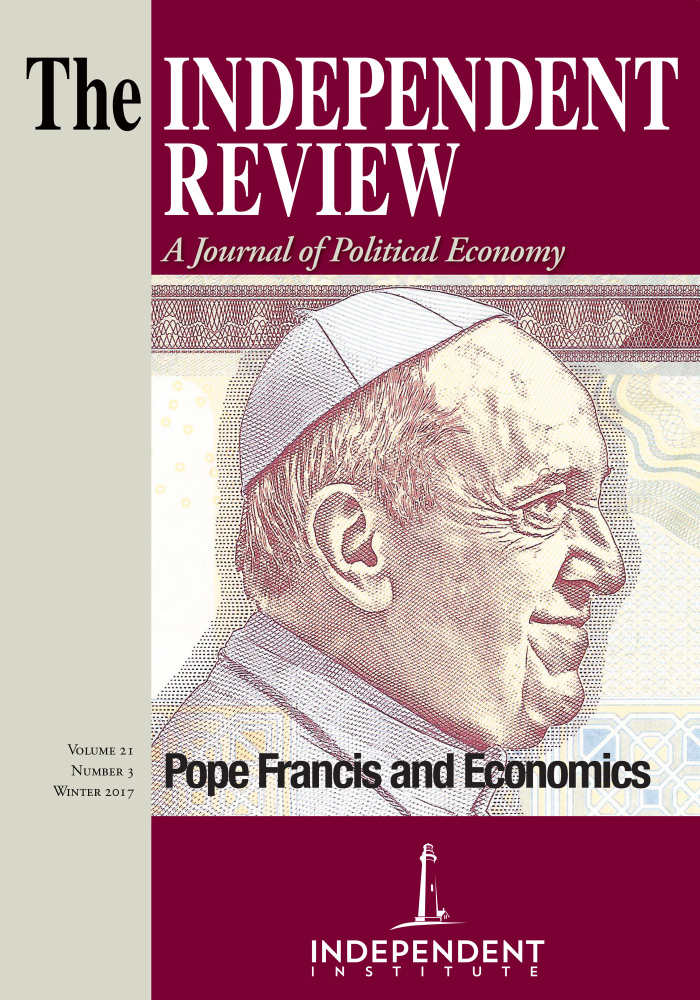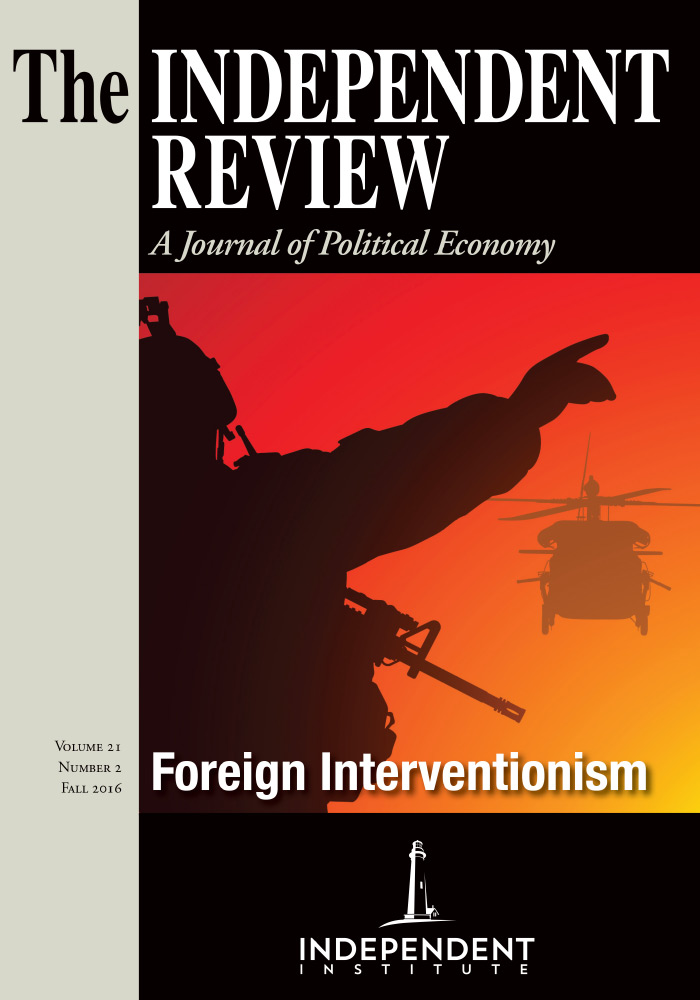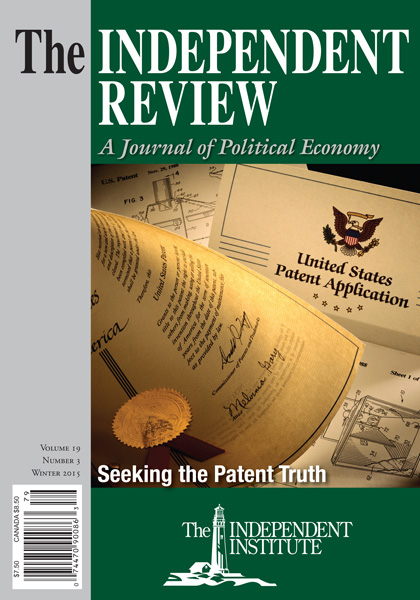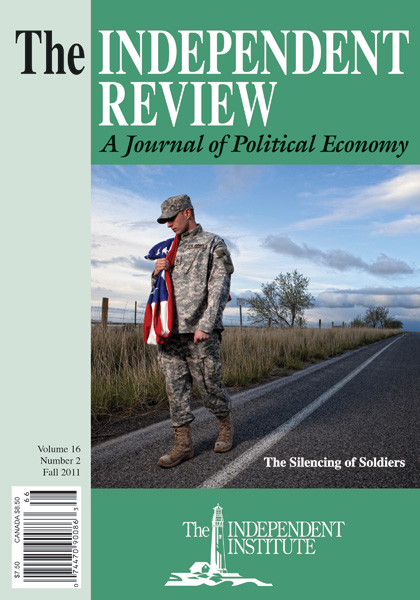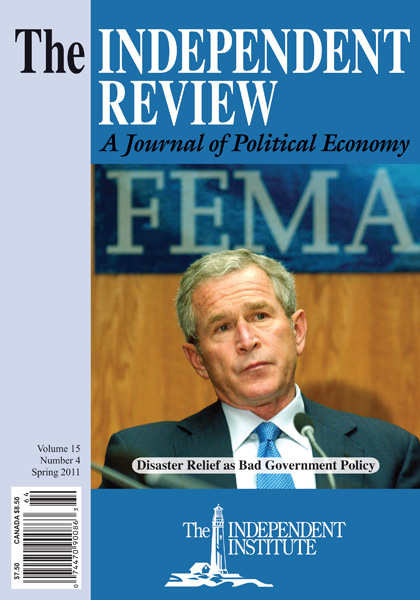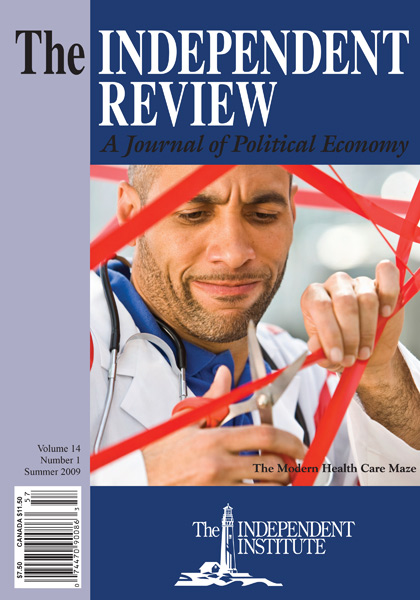Childhood vaccines in the United States have been in short supply since 2000. Although many reports have attributed this shortage to an over-reliance on the free market to deliver needed supplies, numerous obstacles imposed by the U.S. Food and Drug Administration have made the vaccine market far from free.
Article
Since 2000 in the United States, there have been serious supply problems involving nearly all childhood vaccines recommended by the U.S. Centers for Disease Control and Prevention (CDC).[1] Such problems have occurred with other vaccines as well, including influenza vaccine. Some headlines illustrate the story:
“Vaccine Shortages Threaten Kids” (MSNBC News, September 17, 2002)
“Vaccine Shortages Frustrate Everyone” (Amednews.com [American Medical Association] March 4, 2002)
“Health Officials Warn That Flu Vaccine May Be Too Little, Too Late” (Philadelphia Inquirer, September 6, 2000)
“Flu Shot Delays Reported for Many Who Are at Risk” (New York Times, November 7, 2000)
These and other stories tell of frustrated doctors and health-care workers unable to get vaccines (Chang 2000; “Physicians Weigh In” 2002). They describe elderly patients standing in long lines at flu shot clinics or arriving at clinics only to find that supplies had run out (Borgatta 2000; Stapleton 2001). Other stories speak of “price gouging” as hard-to-find vaccines are sold for many times the usual price.
It is unclear why these difficulties happen, but many people place the blame squarely on the free market and vaccine manufacturers. “We’re not distributing shoes for the prom,” one doctor told the Los Angeles Times, November 4, 2000, during the flu vaccine shortage. “This is a public health issue,” she said. U.S. senator Jack Reed of Rhode Island declared, “It’s clear . . . that we have a system that cannot guarantee an adequate supply of vaccines from year to year and is unprepared to handle a potential outbreak of routine childhood diseases.” He called for several government agencies to “coordinate their oversight of manufacturers” (Reed 2002). U.S. representative Peter DeFazio of Oregon stated, “I would hope we’re not making life and death decisions based on someone’s ability to compete in the market.” He introduced legislation that would give the secretary of the Department of Health and Human Services the authority to declare a “public health emergency” by reason of a flu vaccine shortage. The government could then “take title to such quantities of vaccine as the secretary determines to be necessary for purposes of the public health” (U.S. House 2001, emphasis added). On May 21, 2001, DeFazio told the Eugene, Oregon, Register Guard that “a market driven system for delivering vaccine doesn’t work when there’s a shortage or outbreak” (Christie 2001).
Did the free market really fail? Can it deliver only prom shoes and other “nonessential” goods? Is more government intervention necessary to guarantee that Americans get immunizations? In this article, I maintain that the U.S. vaccine market is far from “free” and that government intervention itself has caused the recent supply difficulties.
What Happened?
The vaccine shortages are a recent phenomenon. According to a U.S. Government Accounting Office (GAO) report, childhood vaccine supplies started to run low “in the fall of 2000 when supplies of the tetanus and diphtheria booster (Td) fell short” (U.S. GAO 2002, 8). The supply problem with influenza vaccine also emerged at that time, although the CDC had warned of it a few months earlier (U.S. CDC 2000). Over the next thirty months, nearly all of the CDC’s recommended childhood vaccines were at one time or another in seriously short supply.
Seriousness of the Problem
All of the vaccine supply problems began at approximately the same time. In January 2001, just a few months after the Td and influenza vaccine shortages took hold, the vaccine known as DTaP (for diphtheria, tetanus, and pertussis) fell into short supply. Pneumococcal conjugate vaccine came next (PCV), in September 2001, followed by measles, mumps, and rubella (MMR) and chicken pox (varicella) in October 2001 (U.S. GAO 2002, 8). At the same time, shortages also occurred for the hepatitis B and haemophilus influenzae type b (Hib or meningitis) vaccines (“How to Shore Up” 2002).
State and local immunization programs felt the pinch. All fifty-two state and local programs that responded to a GAO survey reported that they “experienced shortages of two or more vaccines.” Approximately two-thirds reported “shortages with five or more” of the eight vaccines. More than half reported lowering their immunization requirements for kids to attend school (U.S. GAO 2002, 11–12).
Why This Matters
One hundred years ago more than one in ten American infants died from vaccinepreventable diseases. “Since the introduction of vaccines against these diseases, incidence has dropped by 99%” (“How to Shore Up” 2002). Measles, polio, smallpox, and meningitis—all once significant dangers for children—have been virtually eliminated in the United States. Now, however, delayed and sometimes missed vaccinations are putting one hundred years of progress at risk.[2]
According to the GAO, although high “vaccination rates from recent years could delay the immediate effects of deferred immunizations, . . . under-immunization destabilizes population immunity and may lead to outbreaks” (U.S. GAO 2002, 13). According to the CDC, some thirty-six thousand Americans die from flu-related illness each year. Nearly all of these deaths occur in people older than sixty-five. In 2000, the year in which the greatest difficulties in getting the flu vaccine occurred, the vaccination rate for people sixty-five or older fell to 62 percent—down five percentage points from 1999. Among people ages eighteen to sixty-four with diabetes (another group at potentially serious risk from flu), the immunization rate in 2000 was 44.3 percent—down nine percentage points from the previous year (U.S. CDC 2002b). Altogether, approximately 1 million fewer elderly people got flu shots in 2000 than did in 1999,[3] almost certainly because of the difficulty getting the vaccine during the peak demand months of October and November 2002.[4]
Tenuous Supply
Congress asked the GAO to investigate the childhood vaccine shortages. In September 2002, the GAO reported that for the most part the shortages had ended, but it warned that they might recur if disruptions, such as “a catastrophic plant fire” or product recall, took place. Many months might elapse before new vaccines could be made available (U.S. GAO 2002, 19).
The GAO also warned that vaccine supplies are vulnerable because so few companies make vaccines for the U.S. market. A single manufacturer provides five of the eight vaccines that the CDC recommends for children. With so few manufacturers, a single company’s exit from the market can cause a shortage quickly (U.S. GAO 2002, 19–20).[5] The same point had been made earlier by Infectious Disease News, March 2002, when it reported, “it would take only a single manufacturer to discontinue production to lose the vaccine supply for MMR, [chicken pox], inactivated polio and [meningitis]” (“How to Shore Up”).
Just four companies make virtually all childhood vaccines used in the United States.: Merck & Company (United States), Wyeth Pharmaceuticals (United States), Aventis Pasteur (France), and GlaxoSmithKline (United Kingdom). Only two companies still make injectable influenza vaccine for the U.S. market: Aventis Pasteur and Medeva Pharma (United Kingdom, known as Evans Vaccines in the United States).[6]
How the Food and Drug Administration Caused the Problem
It is no coincidence that vaccine shortages started to appear shortly after the U.S. Food and Drug Administration (FDA) launched “a new program for inspecting the biologics industry, called Team Biologics.” Team Biologics was created in 1997, but it “moved to vaccines in October 1999” (U.S. GAO 2002, 15).
Prior to 1999, FDA inspections of vaccine plants “were generally shorter and involved smaller inspection teams.” After Team Biologics took control, however, inspections lengthened, and inspection teams grew. Inspectors began to focus less on purely “scientific or technical issues” and more on compliance with a broader “range of issues, such as quality assurance, record keeping, equipment cleaning, personnel qualifications, and laboratory controls” (U.S. GAO 2002, 15).
Such inspections, whether prior to the introduction of Team Biologics or afterward, fall under the FDA’s authority (granted in the 1962 amendments to the Food, Drug, and Cosmetic Act of 1938), known as Current Good Manufacturing Practice regulations (CGMP). These regulations are the FDA’s “requirements for ensuring that biological products remain safe, pure, and potent through the entire manufacturing process” (U.S. GAO 2002, 15, emphasis added).
When the FDA strengthened its CGMP protocols, it failed to inform the vaccine industry clearly of the change. As economist David Webster stated in a 2002 interview, “FDA didn’t communicate very clearly that they were changing the rules of the game. Because of that, a lot of manufacturers were sort of caught unaware.”
The GAO supports this view in its 2002 report: “FDA did take steps to inform manufacturers about the program changes; however, some manufacturers reported problems related to how well the changes were communicated.” The report also mentions that at least two manufacturers reported problems getting clear guidance from the FDA. It notes that in October 1999, when Team Biologics was moving into the area of vaccines, the FDA printed a “guidance manual detailing the new protocol for conducting [vaccine industry] inspection.” However, this manual was intended for FDA employees and was “not made widely available—only upon request.” Further, the GAO noted that although other FDA compliance manuals are available on the Internet, “the manual for licensed vaccines [was] still not available on line, well over two years after its issuance, nor [was] it included in FDA’s annual comprehensive list of guidance documents published in the Federal Register” (U.S. GAO 2002, 16).
Finding the Cause of the Scarcities
It takes a little reading between the lines to discover that the FDA was at the heart of the recent vaccine-supply problems. In comments to the media and Congress, government (especially FDA) officials have obscured this truth. Here is a typical statement:
the recent shortages stem from a number of factors including: 1) the withdrawal from the market of one manufacturer, 2) difficulties in the manufacturing process, 3) temporary shutdowns of facilities for upgrades or maintenance, or to correct manufacturing deficiencies observed by the manufacturer or FDA during inspections, and 4) other factors, such as transition to thimerosal-free vaccine formulations. (U.S. Senate 2002a, 1)
In the following sections, I show how each of these “factors” can be traced back to the FDA.
Withdrawal from the Market. Most official (especially FDA) statements on the shortages emphasized that some companies left the vaccine business. An FDA press statement on the shortages stated sardonically, “Calling it a business decision, Wyeth Lederle withdrew from the manufacture of DTaP and Td vaccine” (qtd. in Meadows 2002, emphasis added).
The statement fails to mention that Wyeth’s “business decision” came two months after the company had been forced to pay a record $30 million fine under the terms of a CGMP consent decree (“Company News: American Home” 2000; Russell 2002). The decree also forced the company to hire independent inspectors to monitor CGMP compliance at the two plants where violations had been found (in Marietta, Pennsylvania, and in Pearl River, New Jersey). These inspectors were to report directly to the FDA. Any problems they found would have to be fixed on a schedule “approved by FDA.” If the company failed to meet the schedule, it would be forced to pay $15,000 each day it remained in noncompliance, up to a $5 million limit. Despite the steep fine and strict terms, the FDA admitted that it never actually “found contaminated Wyeth products and is aware of no illnesses” resulting from the CGMP violations at the plants in question (U.S. FDA 2000a).
At the same time, a maker of influenza vaccine was jumping through similar FDA hoops. Parkedale Pharmaceuticals was struggling to comply with the terms of its own FDA consent decree. The FDA inspected Parkedale’s influenza vaccine plant in Rochester, Michigan, in October 1999, found a number of CGMP violations, and ordered the company to correct them. Six months later another FDA inspection revealed that the company remained out of compliance. This time the FDA ordered Parkedale to halt production and distribution of its vaccine pending future approval (“FDA Halts” 2000; Miecko 2000b).
A month later Parkedale notified the FDA that it had completed “all actions required by the agency” (King Pharmaceuticals 2000), and the company was allowed to resume manufacturing. FDA monitoring continued. For the next several weeks, Parkedale held “teleconferences” with the FDA and submitted “biweekly written status reports on the corrective actions” it was still taking. Then, on June 9, 2000, Parkedale officials met with officials from the FDA for more discussions. The company said the FDA was “pleased and encouraged by Parkedale’s efforts and progress to date” (qtd. in “Parkedale Pharmaceuticals Meets” 2000).
A few weeks later the FDA conducted another inspection and again ordered a halt to Parkedale’s operations. The agency said its decision was based on its “review of the inspection, the records collected during the inspection, and [Parkedale’s] written responses to the observations” (Miecko 2000a). It did not claim to have found any unsafe vaccine. The agency’s order to halt operations came on September 27, 2000—exactly the time of year when health-care providers usually start to receive influenza vaccines. The FDA gave the company thirty days to implement a number of studies, tests, and new procedures (Miecko 2000a), but the flu shot window is small (most people receive immunizations in September and October), and by the time the FDA’s mandated steps could be completed and approved, it was likely that the demand for flu vaccines would have fallen to almost nothing.[7]
Parkedale announced the next day its decision to withdraw from the influenza vaccine business, writing off some $45 million. The long struggle with the FDA had ended, and despite the financial loss the company’s stock rose on the news (“Company News: King Pharmaceuticals” 2000). The move deprived the market of an expected 12–14 million doses of flu vaccine (U.S. GAO 2001, 6)—approximately 15 percent of the expected total.
David Webster summed up the saga: “You know with Parkedale, they got an FDA citation and they were probably looking at several million dollars to get their production plant into spec. That year the price of influenza vaccine [was approximately $2.30 per dose]; [Parkedale] probably said, ‘how many doses at $2.30 are we going to have to sell to recoup this million-dollar investment?’ The number was probably quite high.” In effect, Webster concluded, the FDA presented Parkedale with a decision “to completely upgrade or leave the business” (Webster 2002).
In testimony before Congress, FDA deputy commissioner Lester M. Crawford left out the months of inspections, meetings, teleconferences, and compliance reports when he summed up the Parkedale saga. He simply told lawmakers that the company “decided not to take action to correct manufacturing problems . . . [and] elected to withdraw from the market” (U.S. Senate 2002a, 2).
Manufacturing Difficulties. When FDA officials spoke of “difficulties in the manufacturing process,” they were referring principally to problems that flu vaccine manufacturers experienced in 2000 getting a particular virus strain to grow. These problems “led to vaccine production and distribution delays of about 6–8 weeks in 2000–01” (U.S. GAO 2001, 5). Three of the (then) four makers of flu vaccine had trouble with the A Panama virus strain.[8] This problem delayed for a month the largest vaccine supplier, Aventis Pasteur, which supplied approximately half of the 70 million doses sold in 2000: the company normally begins shipping flu vaccine in late August and early September, but in 2000 it did not begin shipping until September and did not complete its shipping until December (Patten-Hitt 2000).
Several media and government reports highlighted the A Panama problem when explaining the flu vaccine scarcity in 2000 (Chang 2000; Eisner 2000; Shook 2001; Stapleton 2001), but almost no reports mentioned that the FDA compounded the problem by its unusual tardiness in determining which virus strains to include in the 2000 influenza vaccine. Here is what happened.
Because the virus that gives people the flu changes each year, the vaccine must change each year as well. The FDA decides which three virus strains to include in any given year’s vaccine. If the FDA is slow in making this decision, manufacturers find themselves on a tight schedule. As a result, despite the financial risk, some manufacturers try to guess what mix the FDA will choose in order to get a jump on the production season (Kolassa, Sewak, and Reisetter 2001, 5).
The FDA normally reaches its decision in January or February (U.S. GAO 2001, 4–5), but in 2000 the agency apparently did not determine the three strains until April, even though the World Health Organization had recommended complementary strains in February and European health officials had made their recommendations in March (“FDA Chooses Strains” 2000). If the FDA had made its decision even a month sooner, much of the 2000 influenza vaccine shortage probably would not have happened that year.[9]
Temporary Shutdowns to Upgrade Facilities. According to the FDA and many press reports, some vaccine shortages occurred because manufacturing plants were closed temporarily to upgrade equipment. Some of these accounts mentioned that the FDA had mandated the upgrades, but seldom did they mention that the upgrades might not have been necessary in the first place. Infectious Disease News, March 2002, at least hinted at this possibility: “Regular upgrades to production facilities are mandated by Current Good Manufacturing Practices (CGMP) and can also impact vaccine production and supply. CGMPs compel vaccine makers to pay to keep current with dynamic regulatory standards—investment dollars that could otherwise be spent on developing new vaccines” (“How to Shore Up” 2002).
The FDA, through its CGMP standards, requires vaccine makers to upgrade their production equipment, often at costs of millions of dollars, even when the current equipment is still functioning properly. As noted earlier, the FDA forced Wyeth to spend millions of dollars to upgrade two plants even though the agency “never found contaminated Wyeth products and is aware of no illnesses” stemming from the vaccines being made at the plants (Neergaard 2000). These shutdowns helped to create the shortages of DTaP, Td, and influenza vaccine. Wayne Pisano, an official with Aventis Pasteur, explained to Congress: “The requirement that vaccine manufacturers stay current with technological advances has necessitated a significant and ongoing investment in facilities, including older facilities in which older commodity priced products are produced. These requirements are sometimes put into effect even in the absence of any demonstrated concerns with the vaccines produced in those facilities” (U.S. Senate 2002b).
Thimerosal Removal. The final factor mentioned by the FDA deputy commissioner and in several media reports as contributing to the vaccine shortages was the removal of a mercury-based vaccine preservative known as thimerosal. This substance has been used in vaccines for decades and continues to be used outside the United States (NIAID 2001a). Because it contains tiny amounts of ethyl mercury, however, the FDA decided in 1999 that it should be removed from all childhood vaccines sold in the United States. The American Academy of Pediatrics (AAP) and the U.S. Public Health Service supported the FDA’s decision, but these groups warned that the risk of not vaccinating children far outweighed the danger, “if any,” that thimerosal posed (U.S. GAO 2002, 17).
When vaccine companies set about trying to remove thimerosal, they encountered significant complications and costs. Hence, some vaccine production stalled, and supply problems arose (Kilby 2002). For example, Wyeth had been using the preservative to stabilize its DTaP vaccine and “was not able to completely eliminate it” as required. “This contributed to the manufacturer’s decision to cease production of the vaccine, initiating the shortage of DTaP” (U.S. GAO 2002, 17). Another manufacturer, Aventis Pasteur, found that it had to stop producing DTaP in multidose vials and start using tiny single-shot vials instead. Because each individual dose requires a small amount of additional vaccine (such “overflow” ensures that nurses or doctors draw out enough vaccine), the use of single-dose vials cut Aventis’s production of DTaP by 25 percent (Lavenda 2002; Russell 2002). As Pisano told the Senate Committee on Governmental Affairs, “The net effect is that we invested approximately two years’ development effort to replace an existing product” (U.S. Senate 2002b).
Despite all this, no evidence exists that thimerosal—in the tiny amounts used in vaccines—is dangerous. As one government report states, “The only known sideeffects of receiving low doses of thimerosal in vaccine have been minor reactions such as redness and swelling at the injection site” (NIAID 2001b). Webster summed up the issue nicely: “Often times the FDA decides to do things because they think it’s a good idea. [In the case of] thimerosal, there really wasn’t a scientifically strong case made that it was of any risk, but they just thought it was a good idea” (2002).
Other Vaccine Shortages Linked to CGMPs. Besides causing shortages of DTaP, Td, and influenza vaccines, the FDA’s good-manufacturing regulations caused shortages of several other vaccines. The March 2002 issue of Infectious Disease News stated that shortages of the MMR, Hib, Hep B, and chicken pox vaccines all arose from CGMP issues. The same article lists CGMPs as one of the causes of a shortage of PCV vaccine (“How to Shore Up” 2002). (The other cause was an unexpected surge in demand caused by the CDC’s naming PCV as a “recommended childhood vaccine” [U.S. GAO 2002, 18–19]). Notably, whereas the GAO and Infectious Disease News mentioned both causes of the PCV supply problem, the FDA, in an article on vaccine shortages, mentioned only one: “unexpectedly high” demand (Meadows 2002).
Price Controls. Although the FDA puts upward pressure on influenza and other vaccine prices by constantly expanding regulatory requirements, some childhood vaccines face government-imposed price ceilings. The CDC buys more than half the childhood vaccines manufactured in the United States, and, according to federal law, manufacturers must supply these vaccines at significant discounts—approximately 50 percent (U.S. GAO 2002, 6; “Hillary’s Vaccine Shortage” 2003). These price caps add yet another disincentive for companies to make certain childhood vaccines. The GAO reports, for example, that manufacturers will not sell Td vaccine to the CDC at its officially mandated price. Meanwhile, MMR vaccine, at the time of the GAO report in 2002, was selling exactly at its price cap, which suggests that any significant cost increases that cannot be offset by higher prices might cause the supply of that vaccine to dry up. Only two of the currently recommended childhood vaccines— polio and Hib—were selling below their official caps in 2002. Four others are not subject to price caps because the CDC had not contracted for them prior to May 1993, when the caps went into effect (U.S. GAO 2002, 6).
No price caps exist for influenza vaccine, but when shortages in 2000 and 2001 resulted in predictable price spikes, politicians and lobbyists for the American Medical Association (AMA) screamed “price gouging” (Marquis 2000; Peterson 2000), adding fuel to the fire for those urging more government intervention.
Price “Too Low”? Some analysts believe the flu vaccine shortages of 2000 occurred because the vaccine’s price was too low (Kolassa, Sewak, and Reisetter 2001; Webster 2001), but this explanation seems incomplete. Certainly the preshortage prices in 2000 did not seem “high”—approximately $2.30 per dose—but this price was set in a competitive and free market without government price controls and was sufficient to encourage four companies to participate in the market voluntarily (that is, before they were hit with FDA-imposed upgrades and other expenses). Despite political pressures against vaccine price increases (similar to those against price increases for gasoline and other “essential” commodities), the price of flu vaccine did increase to approximately $6.00 or $7.00 by 2002. The real cause of the flu vaccine shortage of 2000 was not “low” prices. It was the FDA.
Conclusion. In sum, it is certainly possible to obscure the FDA’s role in vaccine shortages. The truth, however, is that vaccine companies left the business because of FDA-mandated plant shutdowns, consent decrees, equipment upgrades, and other costs, often in the face of government-imposed price caps. Difficulties in manufacturing were significant only because the FDA was slow in determining the makeup of flu vaccines. Temporary shutdowns for plant upgrades resulted from FDA demands for “the latest greatest technology” (Kilby 2002) even in the absence of demonstrated need. And thimerosal had to be removed from vaccines not because scientists had shown that it was dangerous in the amounts used in childhood vaccines, but because the FDA thought its removal would be a good idea.
A First Step: End CGMPs
CGMP Reform on the Horizon?
In August 2002, the FDA showed a willingness to relax its CGMP protocols.[10] An FDA plan called “CGMPs for the 21st Century” seems designed to respond to some of the most glaring criticisms of the regulations. Specifically, the initiative will focus CGMP inspections “more squarely on potential risks to public health”—and presumably less on things such as record keeping—and will attempt to ensure that CGMP regulations do not “impede innovation and the introduction of new manufacturing technologies” (U.S. FDA 2002b). The agency also hopes to ensure that inspections are more predictable and that standards are applied consistently from region to region.
It may be too soon to begin celebrating, however. In a memo announcing the new initiative, FDA deputy commissioner Lester Crawford emphasized that making the changes might take “up to two years, or more” and that in the meantime the “FDA remains committed to strong enforcement of the existing regulatory requirements” (U.S. FDA 2002c; see also FDA 2002b).
Indeed, as if to emphasize that it was still serious about enforcing its “standards,” the FDA released this press statement a month after announcing the CGMP initiative:
The FDA will rigorously investigate and prosecute violations of consent decree provisions to the full extent of the law, an agency attorney warned corporate lawyers at a Nov. 12 Food and Drug Law Institute conference on enforcement and litigation issues held in Washington, D.C.
Disgorgement of profits from products made by companies in violation can cost millions of dollars. However, “money is the least of the problems” facing a company when consent decree errors or violations are in question, said Eric Blumberg, deputy chief for litigation in FDA’s Office of the Chief Counsel. “When we get there for an inspection, you’re already on the treadmill,” he said. The agency also will not issue multiple warning letters when consent decree provisions are not being met, Blumberg said. (FDA 2002a)
Notice that the FDA uses an “agency attorney,” whereas the manufacturers use dreaded “corporate lawyers.” Notice also that government fines simply come out of “profits” (“disgorgement”), not out of operating capital, salaries, dividends, or cash flow. And one can only wonder about the significance of the ominous expression that “money is the least of the problems” companies face.
A Closer Look at CGMPs
In 1962, Congress gave the FDA the authority to monitor manufacturing practices in the aftermath of the Thalidomide tragedy in Europe. First known simply as Good Manufacturing Practice (GMP) regulations, these rules eventually were modified by the word current, almost certainly to emphasize the evolving nature of the standards. Now it is common to see the protocols referred to as simply CGMPs.
CGMPs allow the FDA to inspect and regulate even the minutest details of health-care product manufacturing. They give the agency the legal authority to dictate standards for record keeping, lighting, storage, buildings and facilities, maintenance, employee qualifications, and many other aspects of the manufacturing process. They even ban the use of ditto marks on company record sheets (U.S. FDA 2000b) and dictate standards for “washing and toilet facilities” (21 Code [1978] 1993).
CGMPs also give the FDA significant control over manufacturers’ capital equipment. As already noted, they allow the agency to force companies to upgrade equipment even if the current equipment was working properly. They also require FDA approval of any productive innovations. In this way, they clearly inhibit innovations by making them more expensive in time and paperwork; and it is always possible that the FDA will reject the innovation. As one vaccine company official stated, “We are reluctant to make [productive] changes unless they are absolutely necessary.” He added that getting FDA approval for an innovation often takes as long as physically implementing the change (Lavenda 2002).
Vague Regulatory Language Leads to Shifting Standards
The regulatory language that makes up the CGMP protocols is vague; hence, significant changes can be made in enforcement without any actual change in the wording of the regulations. For example, CGMPs allow inspectors to judge whether a laboratory is “adequate” for quality-control testing and whether a company employee is wearing “appropriate” clothing, has “good sanitation and health habits,” and has “sufficient” education and experience to do the assigned job. Such vagueness recurs frequently. A quick perusal of the CGMP guidelines reveals the words adequate, appropriate, and suitable again and again (21 Code [1978] 1993). This vagueness invites the sort of changes in compliance standards that took place in the vaccine industry beginning in 1999. AsWebster explained with regard to the flu vaccine shortage, “The FDA would say, ‘oh, we’ve always had these standards and regulations,’ which is true, but they [started to enforce] them to a much different degree. That’s what really counts; not what’s on the books, but how they are enforced” (Webster 2002).
CGMPs as a Useful Public-Relations Weapon
If FDA officials find themselves in a political crisis, CGMPs can serve as a useful public-relations tool. “‘Violations’ of CGMP regulations can always be found” (Higgs 1995a, 64) and provide a quick route for embattled bureaucrats to appear to be “doing their job.” For example, in the aftermath of an embarrassing FDA bribery scandal in 1989, the agency’s new commissioner, David Kessler,[11]
delegated more enforcement authority to the district offices and encouraged them to use it. Compliance officials encouraged a philosophy of “act now, talk later.” The district offices responded by finding more GMP violations, issuing more warning letters, and taking a variety of other enforcement actions at an increased rate. . . . Says former FDA chief counsel Peter Hutt, “The more enforcement actions, the more FDA employees showed they were protecting the public health.” (Higgs 1995a, 69)
Yet it does not follow that tougher CGMP standards actually improve public safety. Indeed, in the Kessler crackdown just described, “There was no evidence that products had become any safer as a result of the agency’s stepped-up compliance program” (Higgs 1995a, 69). Similarly, in the recent CGMP crackdown on vaccine makers (not to mention the decision to remove thimerosal), no evidence emerged that any vaccines were actually unsafe.
In one case, the FDA found CGMP violations at a Bayer plant making a potentially life-saving hemophilia vaccine known as Factor VIII. On February 10, 2002, the San Francisco Chronicle, reported, a “critical shortage of Factor VIII was created by a November 2000 [FDA] inspection of Bayer Corp.’s Berkeley manufacturing plant. Although the FDA concluded that the product was safe, its 30-page report cited Bayer for multiple problems: The company allegedly failed to properly investigate incidents of bacterial contamination, produced batches of Factor VIII whose potency could not be assured, had inadequate employee training and was sloppy in its record keeping” (Russell 2002, emphasis added). A mother of two children with hemophilia told the newspaper, “We’re down to two doses [of Factor VIII] in the refrigerator. If we had a life-threatening situation, we’d be up a creek.”[12]
The FDA believes that “even seemingly minor CGMP violations” justify plant closures and production delays because “if [the violations] are considered in the aggregate, [they] may indicate a systemic problem affecting product quality” (U.S. Senate 2002a, 3). By this reasoning, if an automobile is found to have a faulty radio or air conditioner, and ditto marks are used on the maintenance log, the whole machine may be deemed defective and dangerous. No proof of any larger problem is necessary—the entire vehicle would be condemned to keep it off the road.
As long as CGMPs exist, they will remain a potential threat to the supply of vaccines and other health-care products. “Despite the name, ‘good manufacturing practice’ violations usually have nothing to do with actual manufacturing or with the quality of the product that reaches the consumer; they almost always consist of failures to fill out countless forms in the minute detail that only a bureaucrat could care about” (Higgs 1995a, 70).
The recent CGMP reform effort is welcome, but doing away with CGMPs altogether remains the best possible solution.
Life Without the FDA
CGMP regulations and the FDA itself exist because of a single assumption: a free market fails to provide adequate incentives for companies to make safe and effective products. Government watchdogs are needed to ensure the safety and efficacy of drugs, vaccines, and medical devices; otherwise, corporations will sell useless “snake oil” and dangerous products to unwitting consumers. My goal in the remainder of this article is to show that this assumption is false. CGMPs and the FDA are patently unnecessary and, indeed, do far more harm than good.
The FDA and its supporters point to the most sensational and tragic instances from the past to justify the agency’s existence and its extensive powers. They often mention a 1901 diphtheria outbreak in which thirteen children died from a flawed remedy or the “Elixir Sulfanilamide tragedy” of the 1930s (out of which the Food, Drug, and Cosmetic Act was born) in which more than one hundred people, most of them children, died. They also mention the tragic results of a morning-sickness drug known as Thalidomide released in Europe in 1960. The drug was effective in relieving morning sickness, yet tragically it caused deformities in some ten thousand children.
Nevertheless, these incidents do not prove that drug manufacturers will not make safe and effective products without government watchdogs monitoring their every move. Manufacturers in a free market have all the incentives they need. They seek profits, not losses. They seek trusted brand names and repeat customers, not tarnished reputations. They seek prosperity, not bankruptcy; and they seek to avoid the massive lawsuits that the tort system virtually guarantees (Krauss 1996), sometimes even in the absence of sound evidence that their products caused harm.
In other words, apart from personal ethics (themselves not without weight), the ultimate motivation for making safe and effective vaccines is self-interest, as Adam Smith pointed out more than two hundred years ago. Just as “it is not from the benevolence of the butcher” that we come to expect our dinner (Smith [1776] 1904, book 1, chap. 2, paragraph I.2.2.), so it is not from the benevolence of the vaccine maker that we come to expect safe and effective inoculations. Just as aircraft manufacturers want to avoid selling planes that will crash and as electronics companies seek to avoid selling devices that will electrocute users, so drug and vaccine makers find it in their own interest to maintain good reputations for making safe and effective products. FDA regulations are not necessary to establish this fundamental condition.
Skeptics might object, however, that vaccines differ from airplanes and lamps. If vaccines work correctly, nothing visible happens—people just don’t get sick! If a vaccine fails, its seller may be long gone before any signs of illness appear; and if adverse side effects follow an inoculation, the consumer may never know that the vaccine caused them. Don’t these potential problems make government intervention necessary?
They do not.
Yes, vaccines do differ from other products, even other health-care products. For one thing, they usually are taken when we are healthy, not sick. Therefore, any perceived risk of negative side effects probably will be magnified in the minds of potential consumers. It is also true that an ineffective vaccine might never be detected, at least not for a long while. And adverse reactions may be very difficult to prove.
Understandably, the public almost certainly would insist on some kind of quality assurance in the realm of vaccines. There is no reason, however, why government should be the guarantor. Private means of assurance are or would become available without the deadly side effects inherent in the FDA’s skewed incentive system.
Private Means of Assurance
“Consumer advocates” and FDA officials warn that corporations cannot be trusted to provide safe and effective products without government supervision. As Dr. Sidney Wolfe of Public Citizen told Congress, drug manufacturers make “decisions based more on who fills their pocketbook than [on] what is best for the public health” (qtd. in Krauss 1996, 463).
Some neoclassical welfare economists echo this belief. In their language, vaccine markets suffer from “asymmetric information,” which means that consumers know almost nothing about the product they are buying. At the same time, producers have an incentive to keep negative information quiet while exaggerating positive claims. Government, the neoclassical welfare economists claim, must correct this informational imbalance. Yet, as Krauss (1996, 463–65) and others point out, informational asymmetries are present in virtually all consumer purchases. Nevertheless, when consumers seek product-quality assurance, a free market provides it.
Examples of private providers of quality assurance include everything from local gossip and trusted brand names to large organizations and companies such as Underwriters Laboratories, Standard and Poors, and magazines such as Consumer Reports and Car and Driver. Others include Arbitron and Nielsen rating services (for potential advertisers unsure about radio and TV audiences) and Good Housekeeping. Even buyers of motorcycle helmets have a private quality-assurance firm, Snell, which provides its seal of approval only to helmets that meet its inspection standards. Helmet manufacturers that wish to convey this level of assurance to consumers willingly pay Snell for this service, and consumers who seek this level of assurance willingly pay more for helmets with the Snell seal of approval (“About Snell” 2003).
Even in health care, despite the presence of the FDA, private providers of assurance exist. As Miller points out, “approval of new medical devices in Europe takes only half as long as in the United States” because the devices are inspected by private “notified bodies” that guarantee that they meet EU standards (2001). Even in the United States, health-care products receive private reviews and approvals in a variety of different ways. For example, “off-label” uses of drugs (that is, uses for which the FDA has not given its approval, yet which doctors are free to prescribe) are reviewed and “approved” in research articles published in “standard reference compendia such as AMA Drug Evaluations, American Hospital Formulary Service Drug Information, and U.S. Pharmacopoeia Drug Indications” (Klein and Tabarrok 2003a, 6; see also Klein and Tabarrok 2003d).
Free markets also deliver quality assurance in many other ways. As Daniel Klein points out (2002), “brand-name” products offer a level of assurance for which consumers are willing to pay—which explains why, other things being equal, a Sears Craftsman tool commands a higher price than the same tool provided by an unknown company. In addition, “middlemen,” such as pharmacists and doctors who become knowledgeable about suppliers of drugs and other health-care products, can charge higher prices for the assurance their knowledge provides. This phenomenon explains why, for example, an established computer dealer can ask more for a used computer than can someone selling the same computer in the classified ads. Indeed, the argument that quality assurance cannot be produced sufficiently in a free market without government intervention seems, in the light of logic and experience, completely absurd: actual markets abound in such provision.
Biased Private Assurance?
Because consumers, doctors, pharmacists, hospitals, and others almost certainly would desire quality assurance for vaccines, there is no reason to believe that private providers of this assurance would not emerge. But would not these private certifiers suffer from a dangerous bias? After all, they would be seeking business from the very companies whose products they would be inspecting. This criticism deserves closer analysis.
The market deals quickly with companies whose reputations for honesty are questioned. (Consider how quickly it destroyed Enron and badly damaged Arthur Andersen.) Consumer Reports, Underwriters Laboratories, Moody’s, Snell, and other providers of quality assurance would have little left if their reputations for unbiased analysis and certification became damaged. Yet these firms also face market pressures to provide their services in a timely manner. They cannot wait years before providing a seal of approval. If they do, other private certifiers will move to provide a better service. In short, private providers of assurance face a duel incentive system: (1) they want to protect their most valuable asset, their reputations, so they must make thorough investigations before providing their “seals of approval”; and (2) they must serve in a timely fashion their clients’ and consumers’ desires for approvals or rejections. If they do not, they will lose out to competitors that provide better service. The FDA, in contrast, has a single incentive system, which is the fundamental reason that its government-granted monopoly on health-care-product certification is so dangerous.
The FDA’s Incentives: One-Sided Caution
A number of scholars have written about the FDA’s skewed incentive system (Quirk 1980; Hansen 1995; Higgs 1995b, 1-10; Carpenter 2001). Economist Ronald Hansen has written:
Inherent in the institutional problem are problems of information and risk perception. On the information side, the public at large, and even many physicians, are basically unaware of what is in the [new drug application] system. . . . Thus there is little pressure [on the FDA] to speed approval. The other problem is rooted in risk perception. Consider a drug that is an improvement in an area where there are already some therapies. Even if the new drug reduces mortality [by 10 percent], usually one cannot identify the 10 percent who would not have survived without the new therapy. But if the drug is shown to be responsible for killing a specific individual, then that loss becomes much more identifiable than all the survivors. (1995, 22)
Or, as Krauss observes, “Every new drug is . . . potentially another Thalidomide to bureaucrats” (1996, 467).
To clarify the FDA’s dilemma, analysts use the terms type 1 and type 2 errors (Quirk 1980, 217–18; Carpenter 2001; Miller 2000). Type 1 errors occur when the FDA approves a drug that later is found to cause real (or perceived) harm to patients. An example is the swine flu vaccine of 1976. Although effective in preventing the flu, the vaccine caused temporary paralysis in some people. When such errors occur, the victims are immediately identifiable. Congress, the news media, “consumer advocates,” and tort lawyers all spring into outraged action. As former FDA official Henry Miller notes, “The developers of the [faulty] product and the regulators who allowed it to be marketed are excoriated and punished in modern-day pillories: congressional hearings, television newsmagazines, and newspaper editorials” (Miller and Conko 2001).
Type 2 errors, however, are committed when a beneficial drug or medical device is delayed, rejected, or otherwise kept from consumers for whom it can prevent illness, improve well-being, or save lives. An example is the FDA’s three-year delay in approval of the ulcer-preventing drug Misoprostol, which had been available in other countries for years. FDA expert Sam Kazman, using the FDA’s own figures, has shown that this relatively unpublicized delay contributed to at least twenty thousand and possibly as many as fifty thousand unnecessary deaths (Henderson 2002, 277).
Political scientist Daniel Carpenter sums up the FDA’s incentive system: “because learning more about [a] drug requires additional studies and additional time to review them, there is always a value to waiting” (2001, 3–4, emphasis in original). Only in unusual cases where the potential users of a new drug or treatment are politically savvy, well organized, and able to command media attention does the FDA sometimes act with alacrity. Carpenter notes, “The case of AIDS offers a lucid example. When ACT-UP protesters, dismayed that the FDA might delay approval of lifesaving therapies, demonstrated at agency headquarters in 1988, they embarrassed the agency and prompted a sharp change in policy on AIDS drugs” (4). Such cases, however, are quite rare.
The FDA’s Record
Approximately 1 million fewer older Americans received flu vaccinations in 2000 than did in 1999, almost certainly because of the supply problems the FDA caused. The CDC estimates that for each additional 1 million vaccinations given to elderly people, nine hundred lives are saved and thirteen hundred hospitalizations are prevented (U.S. GAO 2001, 4). If this estimate is correct, the flu vaccine scarcities of 2000 probably contributed to at least nine hundred deaths and thirteen hundred hospitalizations. The actual figure might be greater because it is possible that, absent the shortage, the number of elderly people receiving flu shots in 2000 would have exceeded that of 1999.[13]
Other examples of deadly FDA obstruction include the following:
- According to Dr. Joel J. Nobel, president of the highly respected organization ECRI (originally known as the Emergency Care Research Institute), possibly as many as several hundred infants died needlessly because of the FDA’s recall of the Bunnell infant jet ventilator in 1992 (Higgs 1995a, 80).
- In 1993, the FDA banned the use of a cardiopump that is standard ambulance equipment in many other countries. Testing had shown that the pump, though not always effective, increased the survival rate for unconscious heart attack victims by 35 percent. The FDA banned the pump because, it pointed out, unconscious victims cannot give their “informed consent” to have the device “tested” on them. This FDA action is estimated to have cost as many as seven thousand lives each year after the ban took effect (Krauss 1996, 467).
- The FDA delayed the release of Interleukin 2, a kidney cancer drug, for forty-two months. This delay is estimated to have cost as many as one hundred unnecessary deaths per month (Krauss 1996, 468).
- The FDA’s ban on advertising the beneficial effects of aspirin for preventing heart attacks is estimated to have caused tens of thousands of preventable deaths—all because the FDA found a tiny (not even statistically significant) increase in the risk of stroke in some patients (Rubin 1995, 29–34).
The list of such examples goes on and on. Indeed, economists who have studied the FDA agree almost unanimously that the agency does far more harm than good (Klein 2000; Klein and Tabarrok 2003b). Klein writes, “I have tried to survey all economists’ writings on the FDA and have not been able to find a single instance of an economist defending the contemporary FDA or advocating tighter restrictions.” They all conclude: “Relax restrictions on drugs and devices” (2000, 18).
Plan for Reform
Many economists have proposed that the FDA’s monopoly on drug approval and certification be abolished and that private certifiers be permitted to compete with the agency. Products that did not go through the FDA’s approval process would be labeled: “NOT APPROVED BY THE FDA.” In this way, consumers who insist on using only FDA-certified drugs would retain this option, but those willing to trust other means of assurance (or none at all) would be free to do so (Grabowski and Vernon 1983, 71; Henderson 2002, 278–80; Klein and Tabarrok 2003c). Given the particular nature of vaccines noted earlier, this approach may be the best path to reform. Many people may desire FDA-approved vaccines, at least until private certifiers gain the desired level of public confidence. Such a plan probably would eventually lead to the obsolescence of the FDA. Why? “The answer is provided by basic economics. Government enterprise, lacking the fusion of motivation and decisive authority in private ownership, simply cannot compete in a field of open competition. . . . If [the FDA’s] privileges against competition (in permitting new drugs or in granting seals of approval) were removed, the FDA would probably sink like a stone, and FDA officials know it” (Klein and Tabarrok 2003e).
Conclusion
The contention that “a market driven system for delivering vaccines does not work” is wrong on two counts. First, its premise that a free-market system exists at all is wrong. The vaccine market in the United States is far from free; indeed, vaccine production is one of the most heavily regulated industries in the country. Vaccine makers have little control over their capital equipment and in some cases even the prices they may ask. The legal ownership of the means of vaccine production is nominally private, but control over those means rests in large part in government hands, rendering their private ownership a legalistic form without substance.
Second, there is no reason to believe a free market would not supply vaccines and vaccine quality assurance just as it supplies other goods and services that consumers seek. However, at least one prominent economist has argued recently that the vaccine market suffers from “market failure” that necessitates government intervention. The argument contends that because vaccines are a “public good” (they have benefits to others besides the people who purchase and use them), they will be underconsumed and underproduced. Therefore, “large government purchases” (and subsidized pricing) can make vaccine producers and consumers better off (Kremer 2000, 12–13).
As the author of this study notes, however, governments are tempted to use their large purchasing power to force below-market prices, thus badly damaging supply incentives. So dismal is the record of “large government purchases” that few companies remain interested in making childhood vaccines for the U.S. market.[14]
This argument also runs into the same theoretical problem from which all “publicgoods” theory suffers—namely, that virtually any good or service can be shown to have benefits that extend beyond those who actually purchased and used it. My neighbors may enjoy looking at my newly painted home or my newly landscaped lawn. Such services may even increase the value of their properties. My decision to bathe myself benefits anyone who comes near me. Do public goods and services therefore include house painting, landscaping, and bathing? Is government intervention required to assure the proper levels of production and consumption (Hoppe 1989, 27–34)?
The market-failure argument contends that “social benefits of vaccines may be ten to twenty times the private benefits appropriated by vaccine developers,” and as a result, vaccines will be underproduced (Kremer 2000, 20). Yet concepts such as “social benefits” and “social costs” are in reality nothing but a collectivist fiction. Individuals, not “society,” experience benefits and costs. We cannot compare the values different individuals place on goods and services because there is no common unit of measurement (Mises 1963, 41–44, 119–27, 145–53); and no government planner can know enough to make the appropriate cost-benefit decisions for other people (Hayek 1937). Further, there is no reason to believe that the planner would make decisions based on the benefits to other people (his incentives may direct him elsewhere) even if somehow he could acquire all the necessary information (Higgs 1995b, 5–9). The planner’s decisions always would amount to simple paternalism at best. Indeed, another justification for the “market failure” argument is that some people may “wait to see [the] benefits [of vaccination] by observing what happens to neighbors who take vaccines” and may “place limited credence in official pronouncements about the benefits of vaccinations” (Kremer 2000, 12)—in other words, some people are too pigheaded to know what’s good for them.
A good first step toward rehabilitation of the crippled U.S. vaccine industry would be to abolish CGMP regulations. An excellent second step would be to allow private providers of assurance to compete with the FDA. If these steps were taken, then eventually the agency responsible for saddling the United States with a “weakened” and “dangerously fragile” (Murphy 2002) vaccine infrastructure would fade into a well-deserved oblivion.
Notes
1. I resist calling the supply problems shortages because in an economic sense shortages can be caused only by price controls. Nevertheless, the popular press, government reports, and even academic papers on this subject refer to the supply problems as shortages. Because this term is much less awkward than scarcities or supply problems, I sometimes use it here as well.
2. Shortages have prompted doctors and clinics to schedule makeup appointments for children as opposed to giving vaccines during routine visits. Often these makeup visits are missed.
3. The CDC recommends influenza vaccines annually for people sixty-five and older, people with weakened immune systems or chronic illness, and pregnant women. These groups are considered “at risk” for serious complications from flu, including death.
4. It takes the body six to eight weeks to build up immunity to the flu, so vaccinations are normally given in October, approximately two months before flu season begins.
5. The University of Massachusetts makes a small amount of Td vaccine for national distribution (U.S. GAO 2002, 20).
6. The limited interest in making vaccines for the U.S. market is no doubt a result of the crippling regulatory environment and government price controls. Owing to FDA preapproval and postapproval requirements, bringing a single drug to market costs an average of $400 million and requires twelve to fifteen years (Miller 2001). A Tufts University study concluded that the “fully capitalized cost to develop a new drug, including studies conducted after receiving regulatory approval, averages $897 million” (Tufts 2001, emphasis added).
7. The CDC placed orders with Aventis Pasteur in November for an additional 9 million doses. Because making flu vaccine takes weeks or months, this order could not be ready until mid-December 2000, by which time the demand for flu vaccine was nearly zero. Some 7 million doses went to waste (U.S. GAO 2001, 10–11; Lavenda 2002).
8. U.K.-based Medeva Pharma reported no problems in growing any of the virus strains and delivered all of its vaccine on time (U.S. GAO 2001, 6).
9. Wyeth also had problems with A Panama, but because it also experienced CGMP delays, it is difficult to know how much of its six-to-eight week delay was attributable to the CGMPs and how much to A Panama.
10. The FDA almost certainly would object to the word relax. In official memos, the FDA characterized the changes in its CGMP protocols as “enhancing” the regulations and building on the “many successes” of the CGMP program (U.S. FDA 2002b, 2002c).
11. The FDA became more aggressive in 1990 when David Kessler took the reins. During the next seven years, he would make headlines by, among other things, placing a moratorium on the sale of silicone breast implants, despite a lack of scientific evidence that they posed a health risk (Higgs 1995a, 65); by attempting to exercise FDA regulatory authority over tobacco; and by attempting to extend the FDA’s jurisdiction to cover preapproval for nutritional and dietary supplements. Indeed, Kessler, who called the FDA “the most important consumer protection agency in the world,” seemed to identify very personally with the FDA; he told Congress in 1995, “I am and the agency is a regulatory agency” (“Parting Interview with David Kessler” 1997, emphasis added).
12. This case is an excellent example of the central problem with the FDA—namely, its monopoly power to make cost-benefit analyses for the rest of us. As biotech consultant Charles Hooper wrote to his friend David Henderson, “drug costs and benefits must be judged within the context of many personal values and tradeoffs: the fear of death, the fear of surgery, the fear of the hospital, potential pain, and the individual’s health profile, financial status, value of time, value of health, and risk tolerance. For the FDA to decide what compounds pass this complex tradeoff is preposterous” (qtd. in Henderson 2002, 278).
13. The percentage of older Americans receiving flu vaccinations had been climbing since 1989, when just 30 percent received the vaccine (U.S. CDC 2002b).
14. In January 2003, President Bush proposed lifting price caps on Td and DTaP vaccines because “vendors . . . concluded it was not economically feasible to sell” the vaccines at the capped prices (U.S. HHS 2003).
References
About Snell. 2003. Motorhelmets.com. Available at: http://www.motorhelmets.com/htm-service/resources-about-snell-table.htm.
Borgatta, Tina. 2000. Hoag Flu Vaccine Gone in a Shot. Los Angeles Times, November 12.
Carpenter, Daniel P. 2001. Groups, the Media, and Agency Waiting Costs: The Political Economy of FDA Drug-Approval. Paper presented at the annual meetings of the Midwest Political Science Association, April 2000, University of Michigan, Department of Political Science.
Chang, Kenneth. 2000. Flu Shot Delays Reported for Many Who Are at Risk. New York Times, November 7.
Christie, Tim. 2001. U.S. Legislators Request Report on Pricing of Flu Vaccine During Shortage. Register Guard (Eugene, Oregon), May 21.
Company News: American Home Products to Pay $30 Million to Settle. 2000. New York Times, October 4.
Company News: King Pharmaceuticals Plans to Stop Making Flu Vaccine. 2000. New York Times, September 29.
Eisner, Robin. 2000. Flu Vaccine Holdup. ABCNews.com, September 13.
FDA Chooses Strains for 2000–2001 Influenza Vaccine. 2000. Infectious Disease News 4 (April). Available at: http://www.infectiousdiseasenews.com/200004/flu.asp.
FDA Halts Parkedale Flu Vaccine; 204 Layoffs Result. 2000. Cranes Detroit Business, November 27. Flu Shot Delays Reported for Many Who Are at Risk. 2000. New York Times, November 7.
Grabowski, Henry G., and John M. Vernon. 1983. The Regulation of Pharmaceuticals: Balancing the Benefits and Risks. Washington D.C.: American Enterprise Institute for Public Policy Research.
Hansen, Ronald W. 1995. FDA Regulation of the Pharmaceutical Industry. In Hazardous to Our Health? FDA Regulation of Health Care Products, edited by Robert Higgs, 13–27. Oakland, Calif.: The Independent Institute.
Hayek, Friedrich. 1937. Economics and Knowledge. Economica 4:33–54. Available at: http://www.virtualschool.edu/mon/Economics/HayekEconomicsAndKnowledge.html.
Health Officials Warn That Flu Vaccine May Be Too Little, Too Late. 2000. Philadelphia Inquirer, September 6.
Henderson, David R. 2002. The Joy of Freedom: An Economist’s Odyssey. Upper Saddle River, N.J.: Financial Times, Prentice Hall.
Higgs, Robert. 1995a. FDA Regulation of Medical Devices. In Hazardous to Our Health? FDA Regulation of Health Care Products, edited by Robert Higgs, 55–95. Oakland, Calif.: The Independent Institute.
———, ed. 1995b. Hazardous to Our Health? FDA Regulation of Health Care Products. Oakland,
Calif.: The Independent Institute.
Hillary’s Vaccine Shortage. 2003. Wall Street Journal, August 15.
Hoppe, Hans-Hermann. 1989. Fallacies of the Public Goods Theory and the Production of Security. Journal of Libertarian Studies 8, no. 1 (winter): 27–46.
How to Shore Up Nation’s Vaccine Supply. 2002. Infectious Disease News 3 (March). Available at: http://www.infectiousdiseasenews.com/200203/vaccine.asp.
Kilby, Jess. 2002. Nobody Is Immune. Portland Phoenix, March. Available at: http://www.portlandphoenix.com/archive/features/02/06/21/feat_vaccine.html.
King Pharmaceuticals (King). 2000. Parkedale Pharmaceuticals Resumes Production of Fluogen. News release. Bristol, Tennessee, April 13.
Klein, Daniel B. 2000. Economists Against the FDA. Ideas on Liberty 50 (September): 18–21.
———. 2002. The Demand for and Supply of Assurance. In Market Failure or Success: The New Debate, edited by Tyler Cowen and Eric Crampton, 172–92. Northhampton, Mass.: Edward Elgar Publishing for The Independent Institute.
Klein, Daniel B., and Alexander Tabarrok. 2003a. Do Off-Label Drug Practices Argue Against FDA Efficacy Requirements? Testing an Argument by Structured Conversations with Experts. Revised March. Available at: http://mason.gmu.edu/~atabarro/DoOffLabel10.pdf.
———. 2003b. Quotations: Economists’ Judgments about the FDA. FDAReview.org. Available at: http://www.fdareview.org/quotations.shtml.
———. 2003c. Reform Options. FDAReview.org. Available at: http://www.fdareview.org/reform.shtml.
———. 2003d. The Sensible Alternative: The Voluntary Provision of Assurance. FDAReview.org. Available at: http://www.fdareview.org/voluntary_assurance.shtml.
———. 2003e. Understanding the FDA’s Opposition to Liberalization. FDAReview.org. Available at: http://www.fdareview.org/understanding_opposition.shtml.
Kolassa, E. M., Saurabh S. Sewak, and Brian R. Reisetter. 2001. An Evaluation and Assessment of the Critical Issues in the Influenza Market: Strategies to Reduce Future Delays in Supply. Jackson: Pharmaceutical Marketing and Management Research Program, Research Institute of Pharmaceutical Sciences, University of Mississippi, School of Pharmacy, October 25.
Krauss, Michael I. 1996. Loosening the FDA’s Drug Certification Monopoly: Implications for Tort. George Mason Law Review 4 (spring): 458–83.
Kremer, Michael. 2000. Creating Markets for New Vaccines. Part I: Rationale. Cambridge, Mass., and Washington, D.C.: Harvard University, the Brookings Institution, and National Board of Economic Research, May 12. Available at: http://ideas.repec.org/p/nbr/ nberwo/7716.html.
Lavenda, Len. 2002. Interview with author. Swiftwater, Pennsylvania, August 14.
Marquis, Julie. 2000. AMA Decries Flu Vaccine Price Gouging. Los Angeles Times, November 4.
Meadows, Michelle. 2002. Vaccine Shortages: An Update. FDA Consumer (September–October). Available at: http://www.fda.gov/fdac/features/2002/502_vacc.html.
Miecko, Raymond V. 2000a. Consent Decree Notification Letter—Parkedale Pharmaceuticals, Inc. [from the U.S. Food and Drug Administration]. September 27. Available at: http://www.fda.gov/cber/ltr/park031000.htm.
———. 2000b. Letter to Jefferson J. Gregory, R., J.D., President, Chief Executive Officer, Parkedale Pharmaceuticals [from the U.S. Food and Drug Administration]. March 10. Available at: http://www.fda.gov/cber/ltr/park092700.htm.
Miller, Henry I. 2000. First Do No Harm. Hoover Digest, no. 4. Available at: http://www-hoover.stanford.edu/publications/digest/004/miller.html.
———. 2001. Americans Are Dying for FDA Reform. Hoover Institution Weekly Essay (April 8). Available at: http://www-hoover.stanford.edu/pubaffairs/we/current/miller_0401.html.
Miller, Henry I., and Gregory Conko. 2001. The Perils of Precaution. Hoover Institution Policy Review no. 107. Washington, D.C. Hoover Institution, June–July. Available at: http://www.policyreview.org/jun01/miller.html.
Mises, Ludwig von. 1963. Human Action. 4th rev. ed. San Francisco: Fox and Wilkes.
Murphy, Eileen. 2002. Weakened Defenses. Johns Hopkins Public Health (fall). Available at: http://www.jhsph.edu/Mag_Fall02/vaccines.html
National Institute of Allergy and Infectious Diseases (NIAID). 2001a. Focus on the Flu: Working Toward a Nasal Spray Flu Vaccine. Washington, D.C.: National Institute of Allergy and Infectious Diseases, November 13.
———. 2001b. NIAID Research on Thimerosal. Washington, D.C.: National Institute of Allergy and Infectious Diseases, October 8.
Neergaard, Lauran. 2000. Wyeth-Ayerst Pays $30 Million for FDA Violations. Associated Press, October 3. Available at: http://www.gulfwarvets.com/wyeth.htm.
Parkedale Pharmaceuticals Meets with FDA to Discuss Progress of Fluogen Compliance Program. 2000. PRNewswire.com, June 12.
Parting Interview with David Kessler. 1997. Online NewsHour, February 10. Available at: http://www.pbs.org/newshour/bb/fedagencies/february97/kessler_2-10.html.
Patten-Hitt, Emma. 2000. CDC Recommends Delaying Influenza Vaccination Campaigns. Reuters Health, July 31. Available at: http://www.emmasciencewriter.com/New%20clips/reuters/influenza.htm.
Peterson, Melody. 2000. Hospitals Question Overpriced Flu Vaccine. New York Times, November 3.
Physicians Weigh in about Vaccine Shortages and Possible Solutions. 2002. Infectious Disease News (April). Available at: http://www.infectiousdiseasenews.com/200204/vaccine.asp.
Quirk, Paul J. 1980. Food and Drug Administration. In Politics of Regulation, edited by James Q. Wilson, 191–235. New York: Basic.
Reed, Senator Jack. 2002. Reed Says Report a Call to Action for Government to Respond to Shortage of Child Vaccines. Press release, September 17. Available at: http://reed.senate.gov/releases/0201.htm.
Rubin, Paul H. 1995. FDA Advertising Restrictions: Ignorance Is Death. In Hazardous to Our Health? FDA Regulation of Health Care Products, edited by Robert Higgs, 29–53. Oakland, Calif.: The Independent Institute.
Russell, Sabin. 2002. Critical Vaccines Run Low; Tetanus Shots Rationed; Congress Probes Shortages. San Francisco Chronicle, February 10.
Shook, David. 2001. If Flu Vaccine Is in Such Short Supply . . . BusinessWeek Online, November 2. Available at: http://www.businessweek.com/bwdaily/dnflash/nov2001/nf2001112_4005.htm.
Smith, Adam. [1776] 1904. An Inquiry into the Nature and Cause of the Wealth of Nations. London: Methuen.
Stapleton, Stephanie. 2001. Flu Vaccine: Enough to Go Around? American Medical News (January 1–8). Available at: http://www.ama-assn.org/amednews/2001/01/01/hlsa0101.htm.
Tufts Center for the Study of Drug Development. 2003. News release: Total Cost to Develop a New Prescription Drug, Including Cost of Post-Approval Research, is $897 million. Boston: Tufts Center for the Study of Drug Development, May 13. Available at: http://csdd.tufts.edu/NewsEvents/RecentNews. asp?newsid=29.
21 Code of Federal Regulations Parts 210 and 211. [1978] 1993. Washington, D.C.: U.S. Government
Printing Office. Available at: http://www.fda.gov/cder/dmpq/cgmpregs.htm.
U.S. Centers for Disease Control and Prevention (U.S. CDC). 2000. MMWR Weekly. Atlanta, Ga.: U.S. CDC, July 14. Available at: http://www.cdc.gov/epo/mmwr/preview/mmwrhtml/mm4927a4.htm.
———. 2002a. Current Vaccine Shortages. Atlanta, Ga.: U.S. CDC, November 19.
———. 2002b. Impact of 2000–01 Influenza Vaccine Supply Delays on Vaccine Utilization. Atlanta, Ga.: U.S. CDC. Available at: http://cdc.confex.com/cdc/nic2002/techprogram/paper_748.htm.
U.S. Department of Health and Human Services (U.S. HHS). 2003. President to Propose Improvements in Childhood Vaccine Programs. Washington, D.C.: U.S. Department of Health and Human Services, January 25.
U.S. Food and Drug Administration (FDA). 2000a. FDA Talk Paper. U.S. Food and Drug Administration. Rockville, Md. October 3. Available at: http://www.fda.gov/bbs/topics/ANSWERS/ANS01041.html.
———. 2000b. Human Drug CGMP Notes. Memo to FDA personnel on CGMP regulations Volume 8, No. 3. September. Available at: http://www.fda.gov/cder/hdn/cnotes0900.htm.
———. 2002a. FDA Pledges Tough Consent Decree Reinspections. November 14. Available at: http://www.gmps.com/pensapipelineApr03.htm.
———. 2002b. FDA Unveils New Initiative to Enhance Pharmaceutical Good Manufacturing Practices. August 21. Available at: http://www.fda.gov/bbs/topics/NEWS/2002/NEW00829.html.
———. 2002c. To: FDA Employees-Agency-Wide, From Deputy Commissioner Lester Crawford, Ph.D. August 21. Available at: http://www.fda.gov/oc/guidance/announce.html.
U.S. Government Accounting Office (GAO). 2001. Report to Congressional Requesters: “Flu Vaccine: Supply Problems Heighten Need to Ensure Access for High-Risk People.” GAO-01-624. Washington, D.C.: U.S. GAO, May.
———. 2002. Report to Congressional Requesters: “Childhood Vaccines: Ensuring an Adequate Supply Poses Continuing Challenges.” GAO-02-987.Washington, D.C.: U.S. GAO, September.
U.S. House of Representatives. 2001. To Amend the Public Health Service Act to Provide for Emergency Distribution of Influenza Vaccine. H.R. 910. 107th Cong., 1st sess., March 7.
U.S. Senate. Committee on Governmental Affairs. 2002a. Statement of Lester M. Crawford, D.V.M., Ph.D. Deputy Commissioner, Food and Drug Administration, Before the Committee on Governmental Affairs. 107th Cong., 2nd sess., June 12.
———. 2002b. Wayne Pisano, Executive Vice President, Aventis Pasteur North America for the Pharmaceutical Research and Manufacturers of America. Hearing Before the Committee on Governmental Affairs. 107th Cong., 2nd sess., July 12.
Vaccine Shortages Frustrate Everyone. 2002. Amednews.com [American Medical Association], March 4.
Vaccine Shortages Threaten Kids. 2002. MSNBC.com, September 17.
Webster, David L. 2001. Who’s Calling the Shots? A Hard-Boiled View of the Flu Vaccine Situation. California Physician (winter). Available at: http://www.websterconsultinggroup.com/flushortage.html.
———. 2002. Interview with author. Lehigh Valley, Pennsylvania, July 1.

